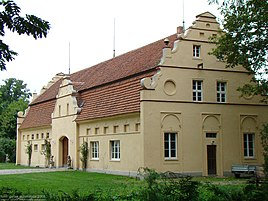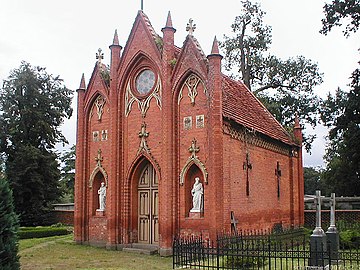Great Gievitz
|
Great Gievitz
Community Peenehagen
|
||
|---|---|---|
| Coordinates: 53 ° 34 ′ 53 ″ N , 12 ° 46 ′ 52 ″ E | ||
| Height : | 40 m | |
| Area : | 19.87 km² | |
| Residents : | 470 (December 31, 2010) | |
| Population density : | 24 inhabitants / km² | |
| Incorporation : | January 1, 2012 | |
| Postal code : | 17192 | |
| Area code : | 039934 | |
|
Location of Groß Gievitz in Mecklenburg-Western Pomerania |
||
|
Groß Gievitzer Marstall on the estate
|
||
Groß Gievitz is a district of the municipality of Peenehagen in the Mecklenburg Lake District in Mecklenburg-Western Pomerania. Until the end of 2011 it was an independent municipality with the districts Carlsruh, Klein Gievitz, Minenhof and Carefree.
geography
Groß Gievitz in the Mecklenburg Lake District is located at the exit of the Ostpeene from the Torgelower See . The city of Waren (Müritz) is nine kilometers away. The slightly hilly area around Groß Gievitz reaches a maximum of approx. 65 m above sea level. NN.
history
Groß Gievitz is believed to have been founded in the 13th century by Westphalian farmers and knights in the previously Slavic area of Schlön. The place name is derived from the Old Slavic word gvoru (water bubble) and probably means Seedorf , with Groß Gievitz probably the younger German settlement and the district Klein Gievitz the older, originally Slavic settlement. The church goes back to the time of German settlement in the 13th century.
The place was mentioned for the first time in 1316 in a land partition agreement between Prince Johann II and Henning von Werle . The property on the site was distributed among various noble families, including the Voss , whose oldest surviving Gievitz feudal deed dates from 1332, but who may have had wealth there since the German settlement of the place. The Hahn and the Flotow also owned the site . In the 16th century, the entire property came to Messrs. Flotow auf Stuer and Hahn auf Basedow, but in the 17th century the Voss acquired sole ownership of the Gievitz estates.
After the place had been devastated in the Thirty Years War , the rebuilding of the estate took place in particular under Ernst Christoph von Voss (1655-1720). His nephew and heir Friedrich Ernst von Voss (1700–1738) died young and left two underage sons, from whom Johann Ernst von Voss (1726–1793) received the goods in Gievitz, Schönau and Rumpshagen . Since he was district president in Magdeburg and from 1763 court marshal to the Prussian queen, he only stayed in Gievitz in late summer and autumn, and most recently only for weeks with his wife Sophie Marie von Pannewitz . In 1796, the latter, who in the meantime had risen to become Chief Chamberlain herself, received a visit from the Prussian Queen Luise and her husband, King Friedrich Wilhelm III , in Gievitz .
The oldest houses in the village that have survived today date from around 1750. Around 1800 the place was described as a dirty village with around 30 clay-roofed cottages. After a fire in 1820, under Felix von Voss (1801–1881) a lot of the building stock in the place was renewed. Groß Gievitz gained importance as a craft village and until 1848 had market justice .
The last Count of Voss, Felix von Voss (1856–1931), sold the estate in 1929 to a Rittmeister Kothe, who, however, sold it to Nordsiedlung GmbH in Berlin in 1935 due to economic problems. The northern settlement then initiated the settlement of the place with settlers from Schleswig-Holstein, for which four new court settlements were created outside the place. Most of the settlers returned to their old homeland in West Germany after 1945. The farms were further parceled out in the course of the land reform and given to new settlers who had come to Mecklenburg as expellees from East and West Prussia, Pomerania and the Sudetenland.
On July 1, 1950, the previously independent community carefree was incorporated. On January 1, 2012, the municipalities of Groß Gievitz, Hinrichshagen and Lansen-Schönau merged to form the new municipality of Peenehagen.
politics
coat of arms
|
Blazon : "Under a golden wave shield head, inside a running red fox, in blue a torn, five-leaf golden oak with four golden fruits."
The coat of arms was registered under No. 308 of the coat of arms of Mecklenburg-Western Pomerania. |
|
flag
The flag of Groß Gievitz is evenly striped lengthways in blue and gold (yellow). In the middle of the flag is the municipal coat of arms, two thirds of the height of the blue and gold (yellow) stripes. The relation of the height of the flag cloth to the length is like 3: 5.
Attractions
- The village church Groß Gievitz is a stone church from the 13th century. It consists of a rectangular nave with two bays and a square west tower. The church has wall paintings from around 1300, as well as ornate furnishings such as an altarpiece, gallery parapet, pulpit and patron s box from the 18th century.
- The manor, located in a park, dates from the 18th century. Of the original building stock, in the manor house of which the remains of a round medieval fieldstone tower were once opened, only the stables have been preserved. The present mansion is more recent.
- The neo-Gothic burial chapel of the Counts von Voss in the cemetery of Groß Gievitz was built in 1827–1831 based on a drawing by Karl Friedrich Schinkel . The chapel has been owned by the parish since 1951 and has served as a cemetery chapel ever since.
- Neo-Gothic chapel (around 1900) and former manor house (mid-19th century) in the Schwastorf district
- Fox oak north of the village with a chest height of 8.70 m (2016).
- Attractions
Infrastructure
From Groß Gievitz there are road connections to Waren (Müritz) and to federal road 194 (Waren - Stavenhagen ). The nearest train station is in Waren (main line Berlin - Rostock ).
Groß Gievitz is the primary school location, there is also a daycare center. In addition to agriculture, gentle tourism is playing an increasingly important role - several holiday apartments were built near the approx. 2 km² large Torgelower See. From 2007 to the end of 2016 there was a brewery in the village called Eick Bräu - Gievitzer Braumanufaktur , whose beers were also available in specialist beer shops outside the region.
Village life is shaped by the volunteer fire brigade and five associations. They are responsible for the traditional park festival and the annual equestrian games.
Personalities
- Ulrich Becker (born June 26, 1791; † October 6, 1843 in Domhof Ratzeburg), high school rector
literature
- Wera Bollmann: field stone church Groß Gievitz. (With an outline of the local history). Schnell & Steiner publishing house, Regensburg 1997.
supporting documents
- ↑ Federal Statistical Office
- ^ Entry in the directory of monumental oaks . Retrieved January 10, 2017
- ↑ http://gievitzer.de/







